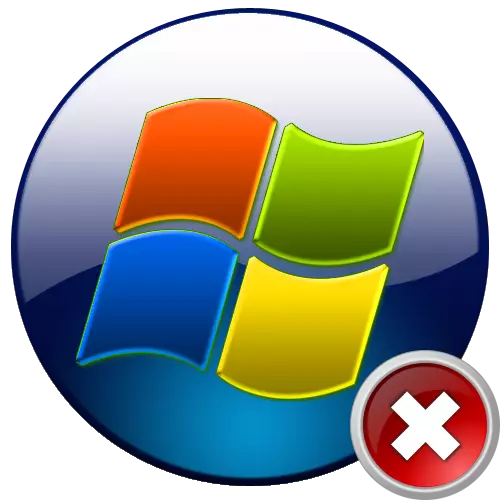
Sometimes when you try to start the "Group Policy Editor" of users, users meet an unpleasant surprise in the form of an error message: "gpedit.msc is not found." Let's deal with what methods can be eliminated by this problem in Windows 7, as well as find out what exactly is its cause.
Causes and ways to eliminate errors
The error "gpedit.msc is not found" says that the gpedit.msc file is missing on your computer or access to it is incorrectly configured. The consequence of the problem is that you simply cannot activate the Group Policy Editor.The direct problems of this error are quite different:
- Removing or damage to the GPedit.msc object due to viral activity or user intervention;
- Incorrect OS settings;
- Using the editorial office of Windows 7, in which the default GPedit.msc is installed.
At the last point you should stop more. The fact is that not all the editions of Windows 7 installed this component. So it is present at Professional, Enterprise and Ultimate, but you will not find it in Home Basic, Home Premium and Starter.
Specific Methods for eliminating the "gpedit.msc not found" error depend on the root cause of its occurrence, the editorial board of Windows 7, as well as the system's bit (32 or 64 bits). Details of various ways to solve this problem will be described below.
Method 1: Installation of the GPedit.msc component
First of all, find out how to install the gpedit.msc component in case of its absence or damage. Patch that restores the work of the Group Policy Editor, is English. In this regard, if you are using Professional, Enterprise or Ultimate, it is possible before applying the current option, you better try to solve the problem with other methods described below.
At the very beginning, we strongly recommend creating a system recovery point or make it backup. All actions you perform at your own risk and risk, and therefore, in order to avoid unpleasant consequences, it is necessary to inspire yourself to then do not regret the consequences.
Let's start a story about the procedure for installing a patch from the description Algorithm of Action on Computers with 32 Bit OS Windows 7.
Download patch gpedit.msc.
- First of all, download the archive on the link above from the Patch Developer website. Unpack it and run the file "setup.exe".
- The "Installation Wizard" opens. Click "Next".
- In the next window you need to confirm the start of installation by clicking the "Install" button.
- Installation procedure will be made.
- To complete the work, click "Finish" in the Installation Wizard window, which will be reported on the successful end of the installation process.
- Now when activating the "Group Policy Editor", the necessary tool will be activated instead of the appearance of an error.
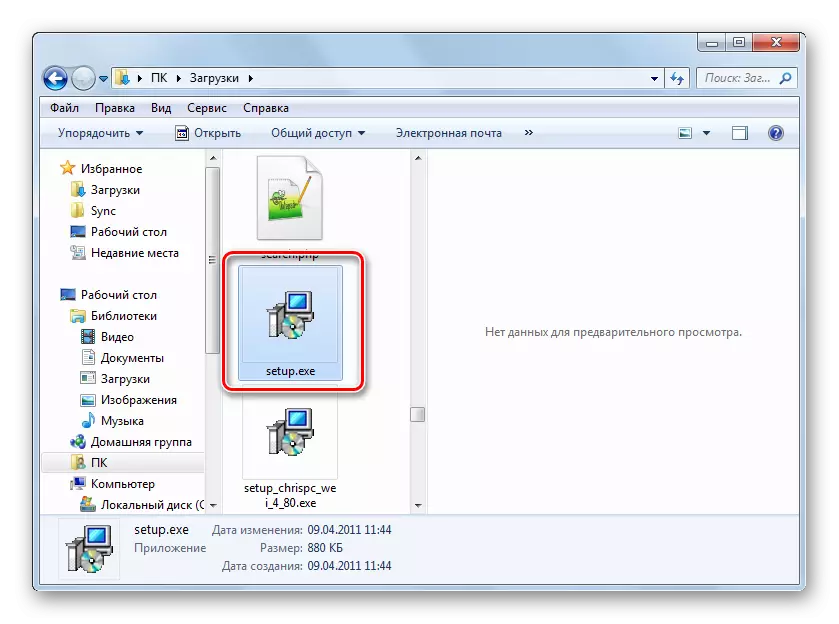
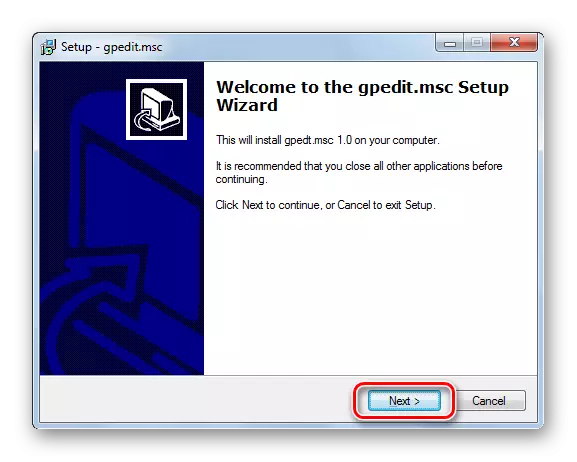
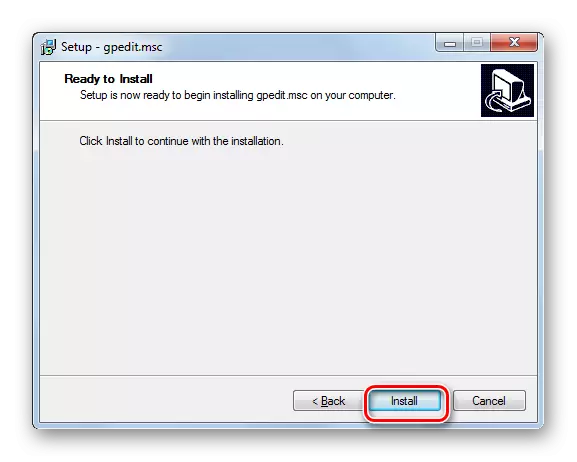
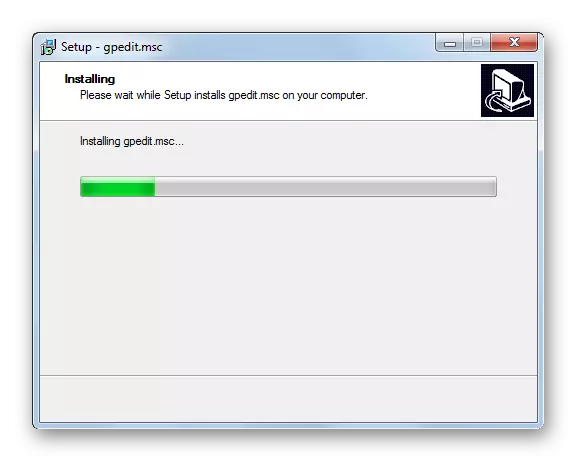
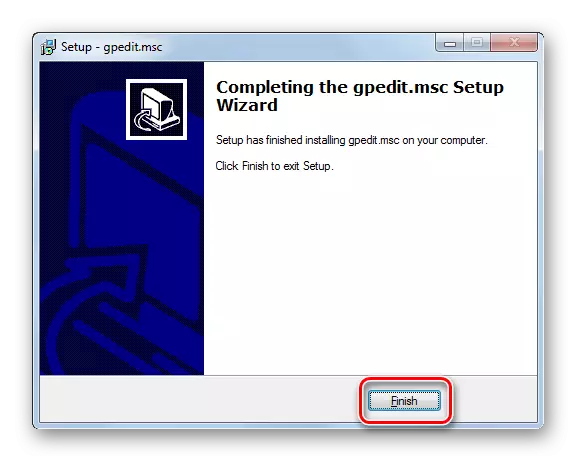
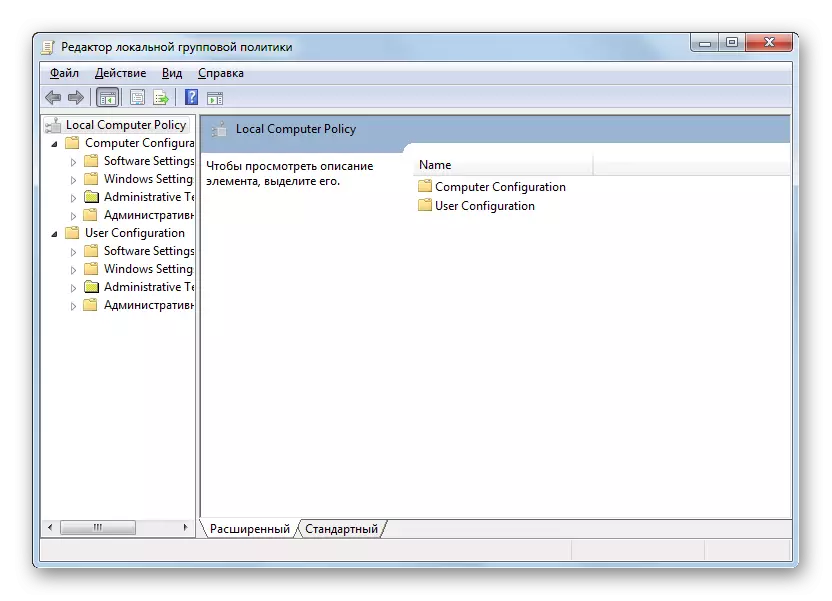
The process of eliminating the error on the 64-bit OS Slightly different from the above version. In this case, you will have to perform a number of additional actions.
- Perform all the above steps to the fifth item inclusive. Then open the "Explorer". We take the next way to its address line:
C: \ Windows \ syswow64
Press the ENTER or click the cursor over the arrow to the right of the field.
- The transition to the SYSWOW64 catalog is performed. Pressing the Ctrl button, click the left button with the left mouse button (LKM) by the names of the GPBak directories, "grouppolicyusers" and "grouppolicy", as well as the name of the "gpedit.msc" object. Then click on the right mouse button (PCM). Choose "Copy".
- After that, in the address bar of the "Explorer", click on the name "Windows".
- Going to the "Windows" directory, go to the "System32" directory.
- Once in the folder specified above, click PCM on any empty place in it. In the menu, select the "Insert" option.
- Most likely, a dialog box will open in which you will need to confirm your actions by clicking on the inscription "Copy with replacement".
- After executing the action described above or even instead, if the copied objects in the System32 directory will be missing, another dialog box will open. Here, too, you need to confirm your intentions by clicking "continue."
- Next, enter the expression to the "Explorer" in the address bar:
% WINDIR% / TEMP
Click the arrow to the right of the address bar or just press ENTER.
- Going to the directory where temporary objects are stored, find items with the following names: "gpedit.dll", "appmgr.dll", "fde.dll", "fdeploy.dll", "gptext.dll". Hold down the Ctrl key and click the LX for each of the above files to highlight them. Then click on the allocation of PCM. Select in the "Copy" menu.
- Now at the top of the "Explorer" window to the left of the address bar, click on the "Back" element. It has an arrow shape directed by the left.
- If you all listed manipulations are performed in the specified sequence, you will return to the "System32" folder. Now it remains to click the PCM on the empty area in this directory and select the "Paste" option in the list.
- Confirm again in the dialog box.
- Then restart the computer. After rebooting you can run the Group Policy Editor. To do this, type the Win + R combination. The "Run" tool opens. Enter such a command:
gpedit.msc.
Click "OK".
- In most cases, the desired tool must start. But if an error still appears, then perform all the listed steps for installing a patch to paragraph 4 inclusive. But in the installation window of the installation wizard, the "FINISH" button do not click, and open the "Explorer". Enter such an expression to the address bar:
% WINDIR% / TEMP / GPEDIT
Click on the transition arrow to the right of the address string.
- After hitting the right directory, depending on the acting system's trim, twice the LKM on the "x86.bat" object (for 32-bit) or "x64.bat" (for 64-bit). Then try again to activate the "Group Policy Editor".
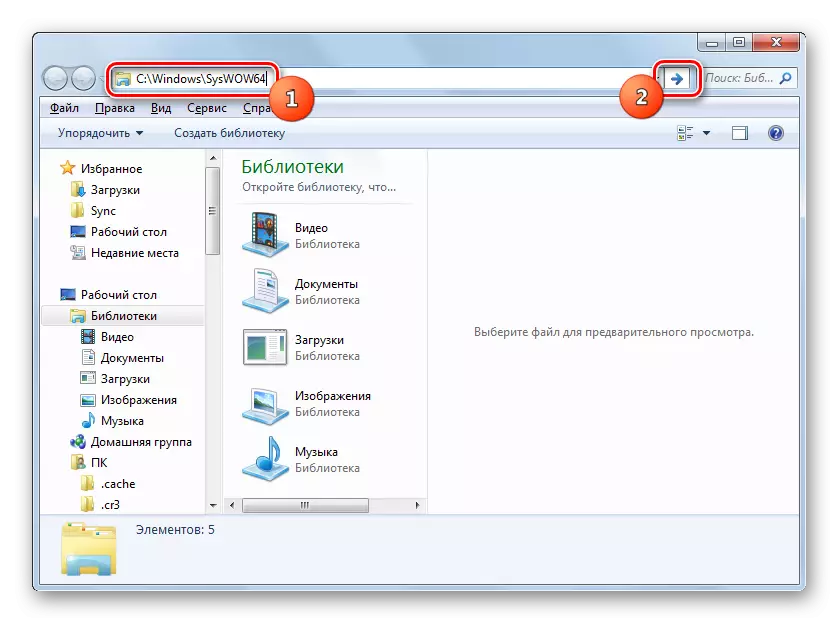
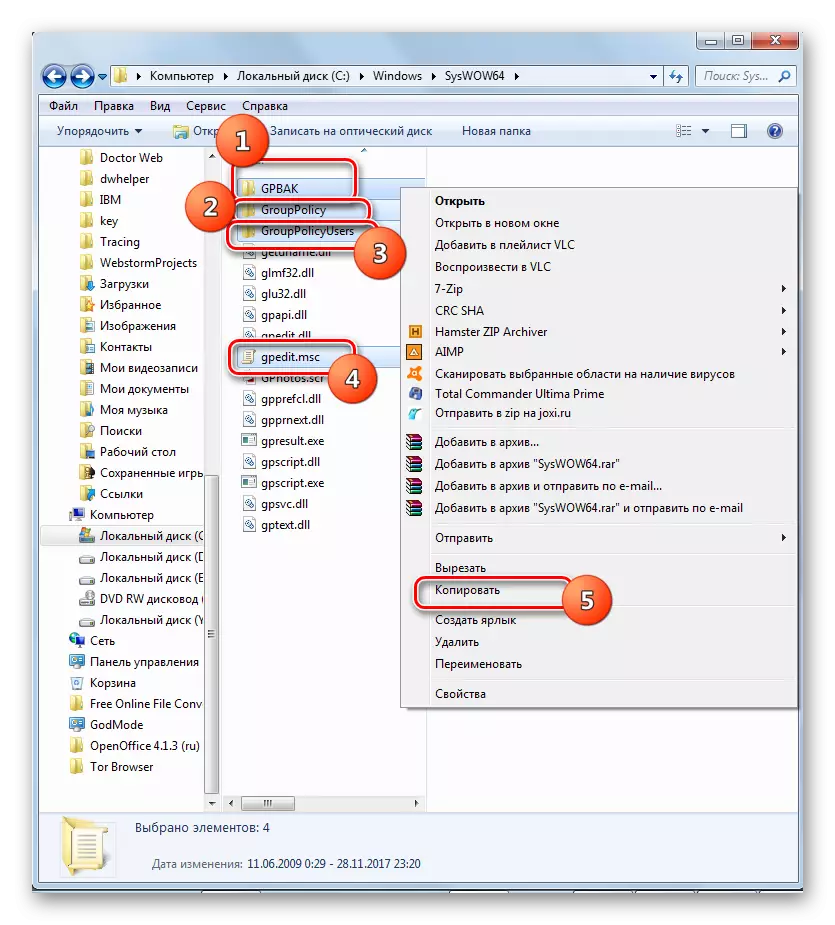
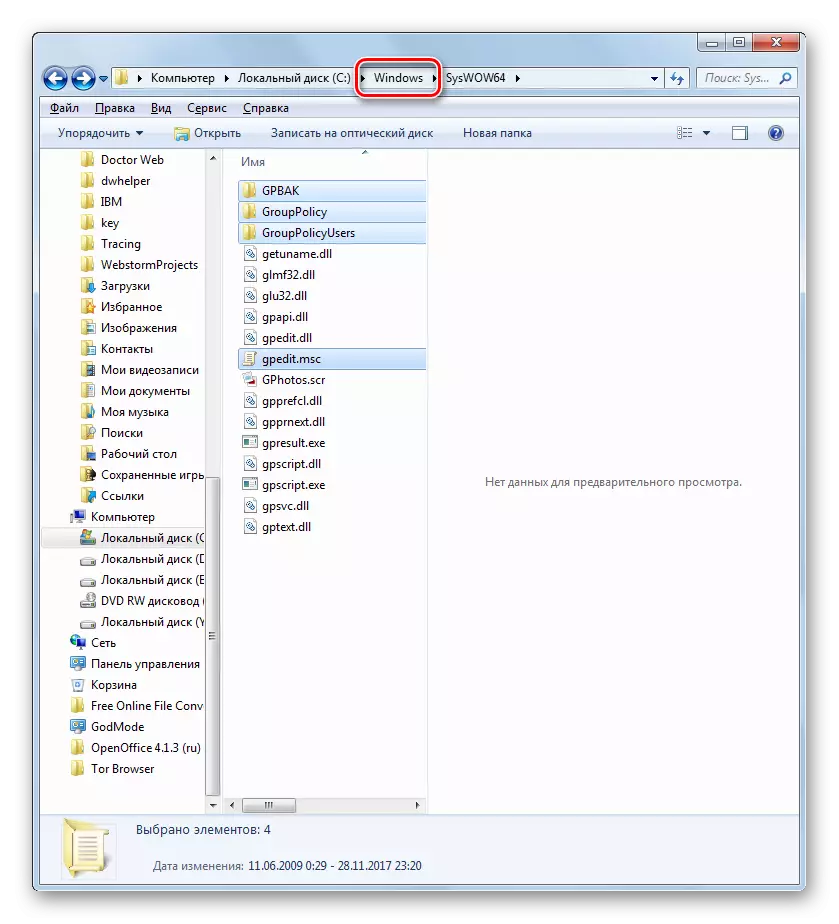
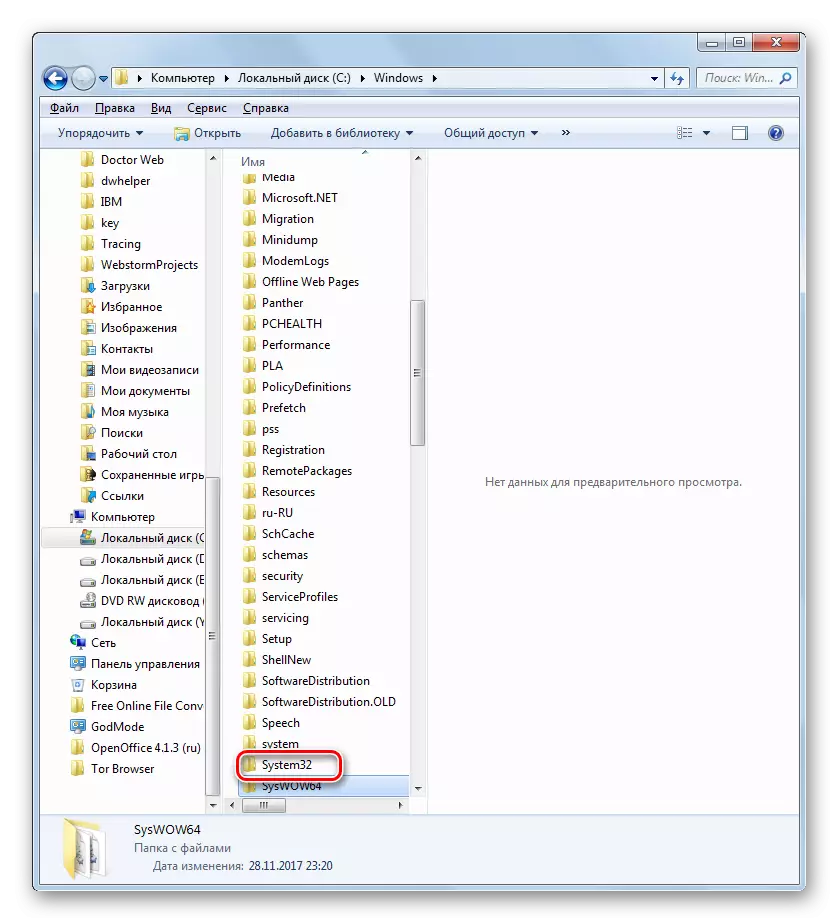
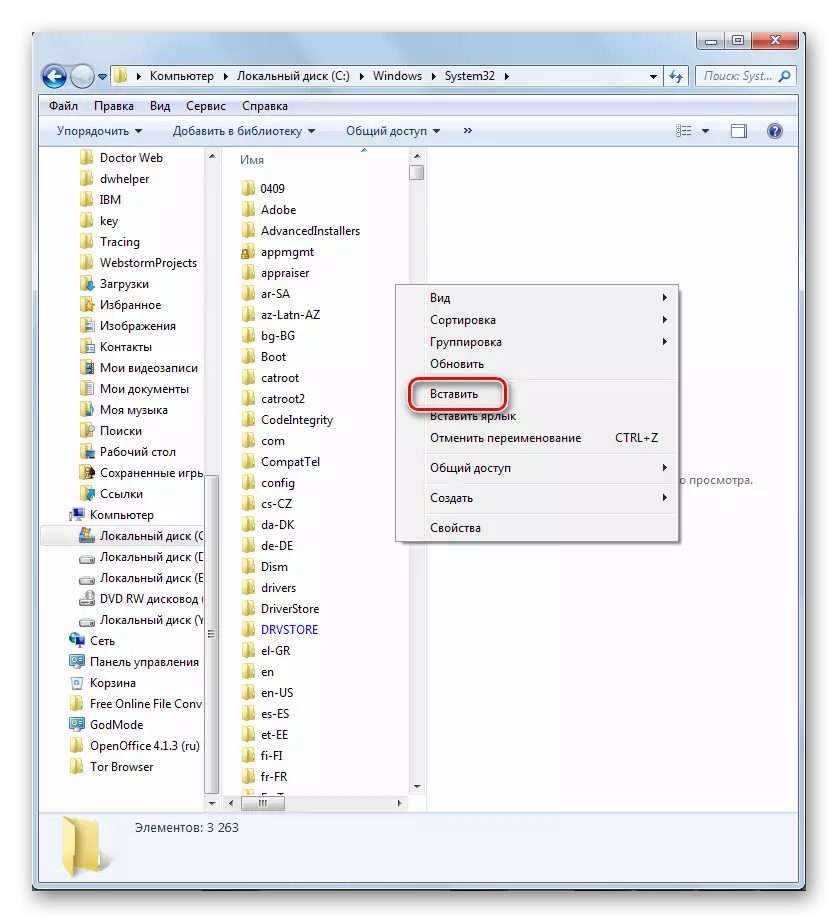
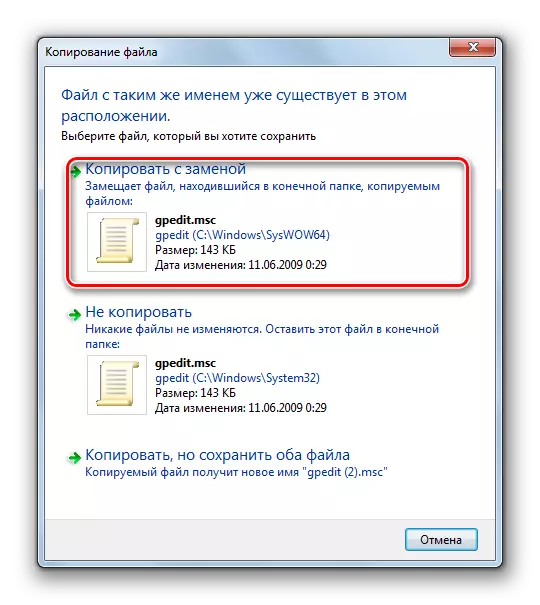
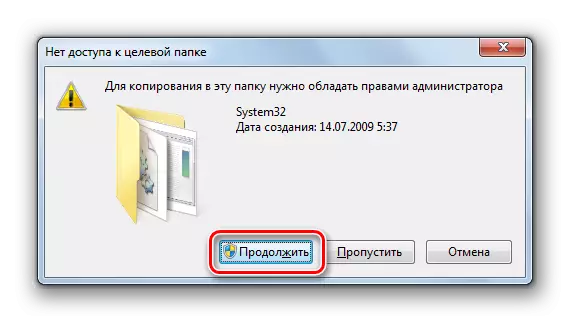
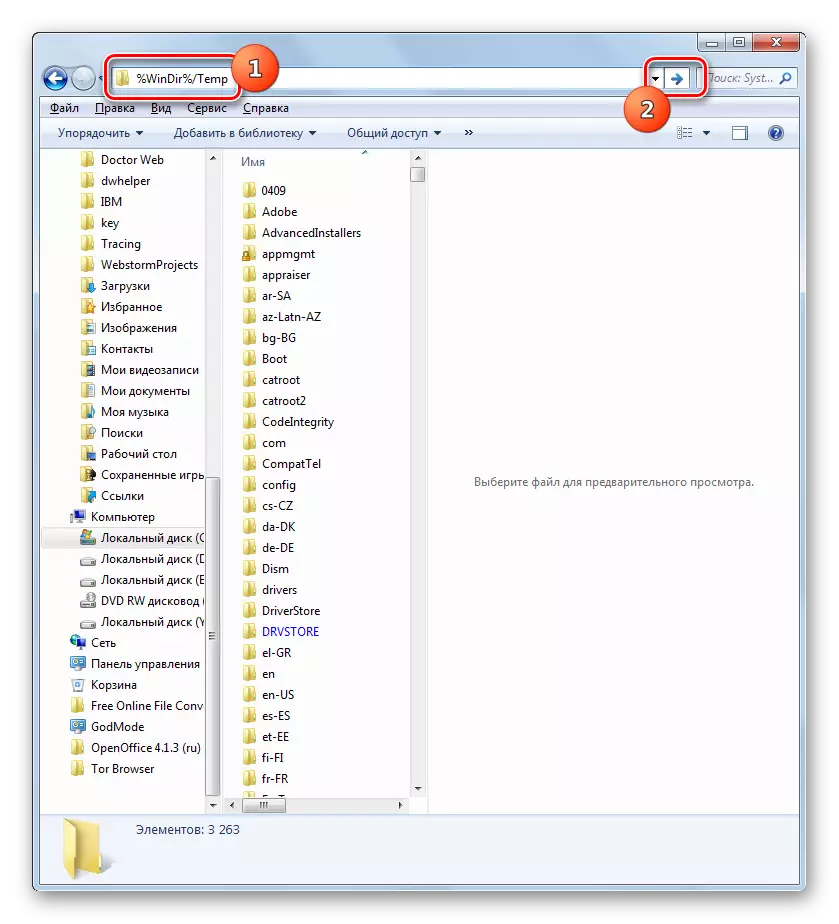
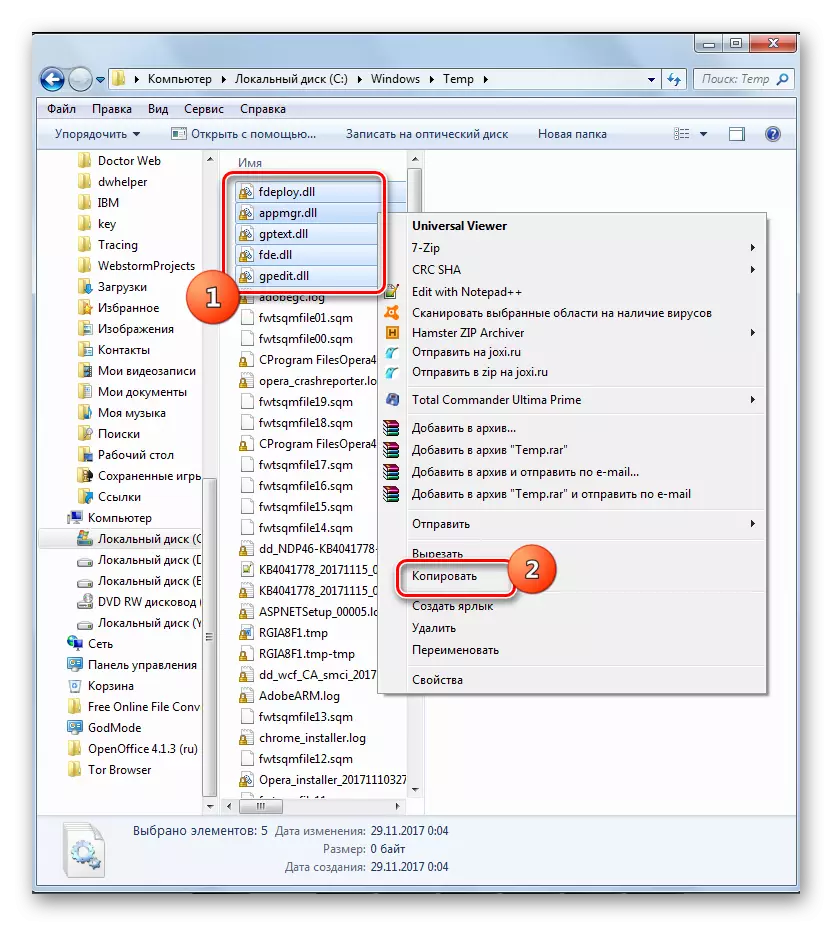
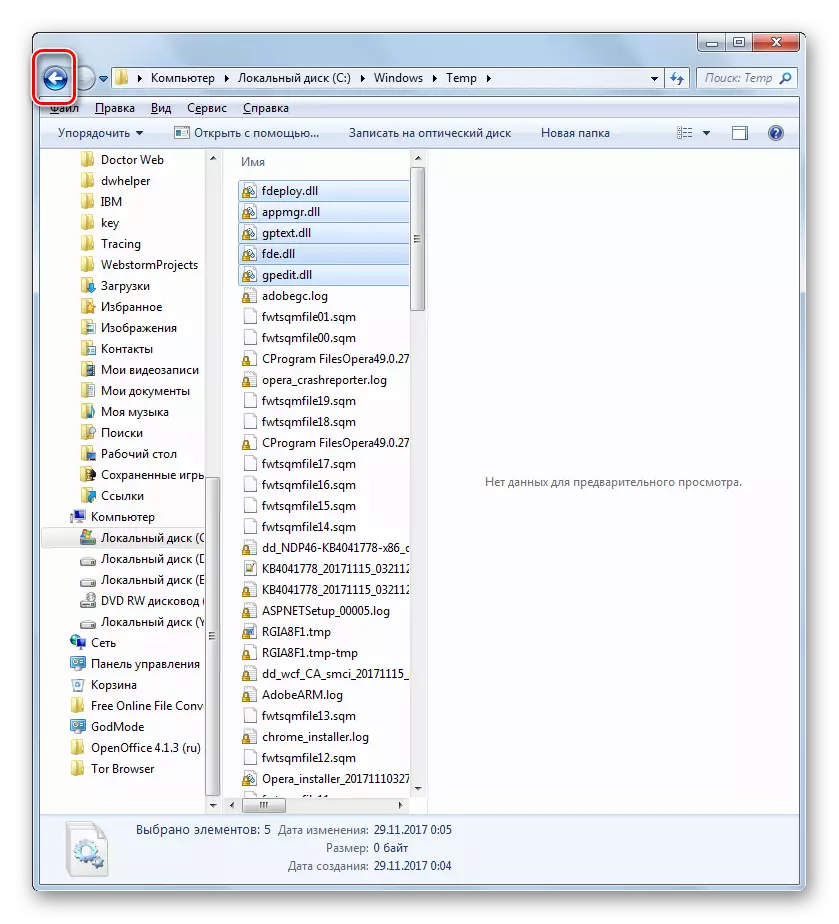
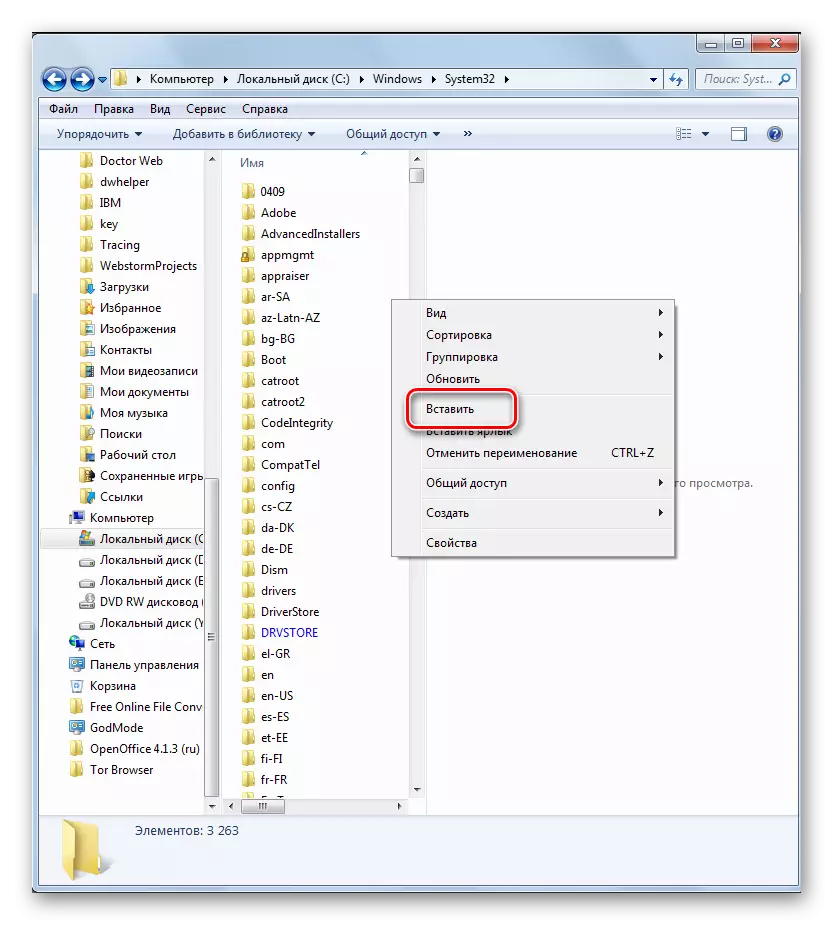
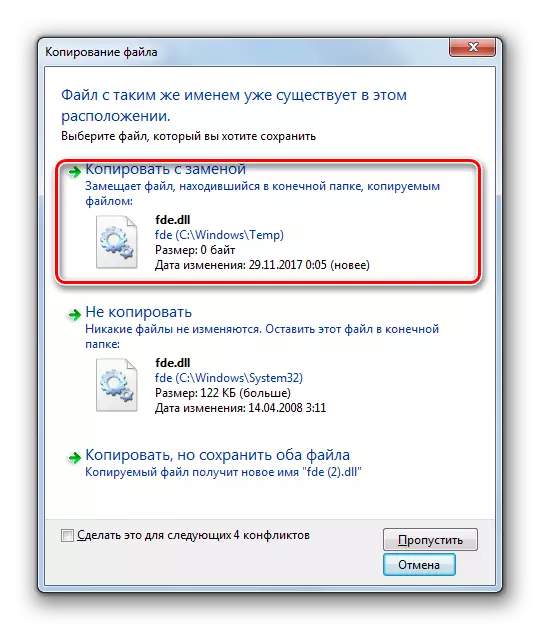
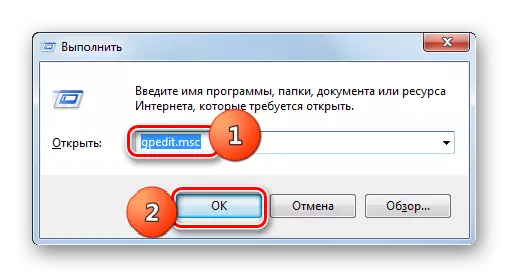
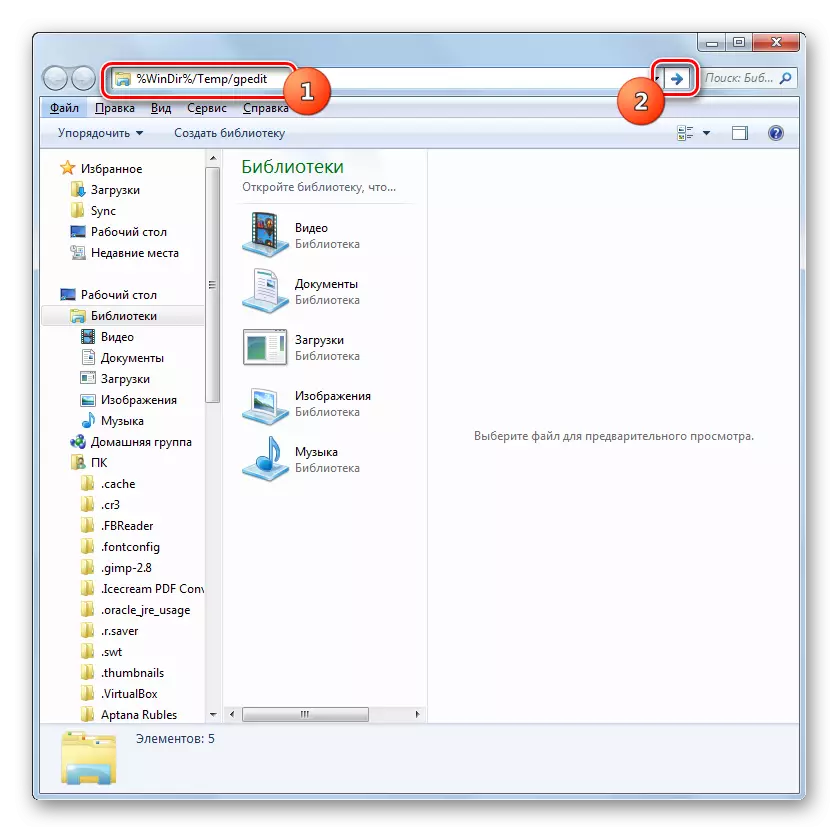
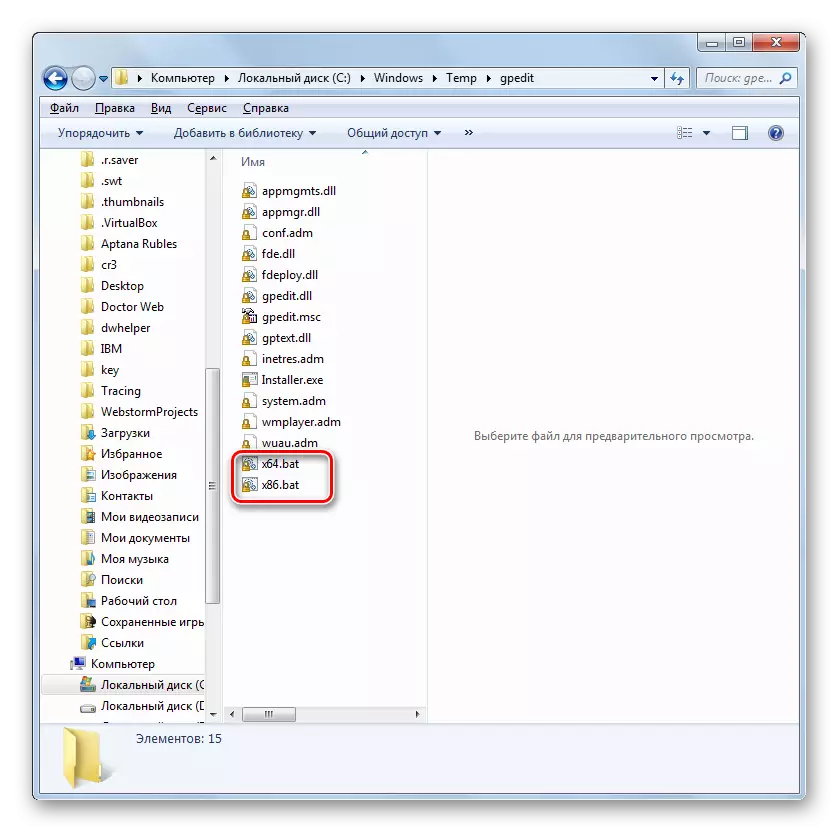
If name Profile under which you work on a PC contains gaps , Even when performing all the above conditions, when trying to start the Group Policy Editor, an error will occur, regardless of which discharge your system. In this case, in order to be able to run the tool, you need to make a number of actions.
- Do all the operations for installing a patch to paragraph 4 inclusive. Go to the "GPEDIT" directory as indicated above. Once in this directory, click the PCM on the object "x86.bat" or "x64.bat", depending on the site's trimming. In the list, choose the "Change" item.
- The text content of the selected object in notepad opens. The problem is that the "command line" that processes the patch does not understand that the second word in the account is a continuation of its name, and considers it the beginning of a new team. To "explain" the "command line", how to properly read the contents of the object, we will have to make a small change in the patch code.
- Click on the Edit Notepad menu and choose the "Replace ..." option.
- The "Replace" window is started. In the "What" field fit:
% UserName%: F
In the "What" field enters such an expression:
"% Username%": F
Click "replace everything."
- Close the Replace window by clicking on the standard closing button in the corner.
- Click on the "File" Notepad menu and select "Save".
- Close the notepad and return to the "GPedit" directory, where the changeable object is placed. Click on it by PCM and select "Run from the administrator."
- After the command file is executed, you can harrow "Finish" in the "Installation Wizard" window and try to activate the Group Policy Editor.
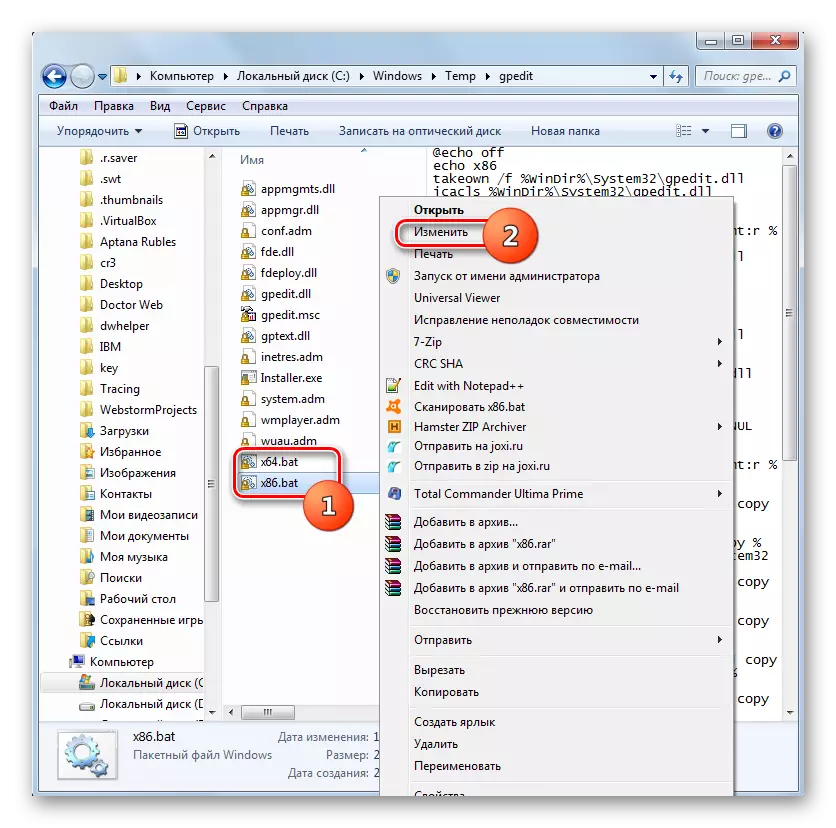
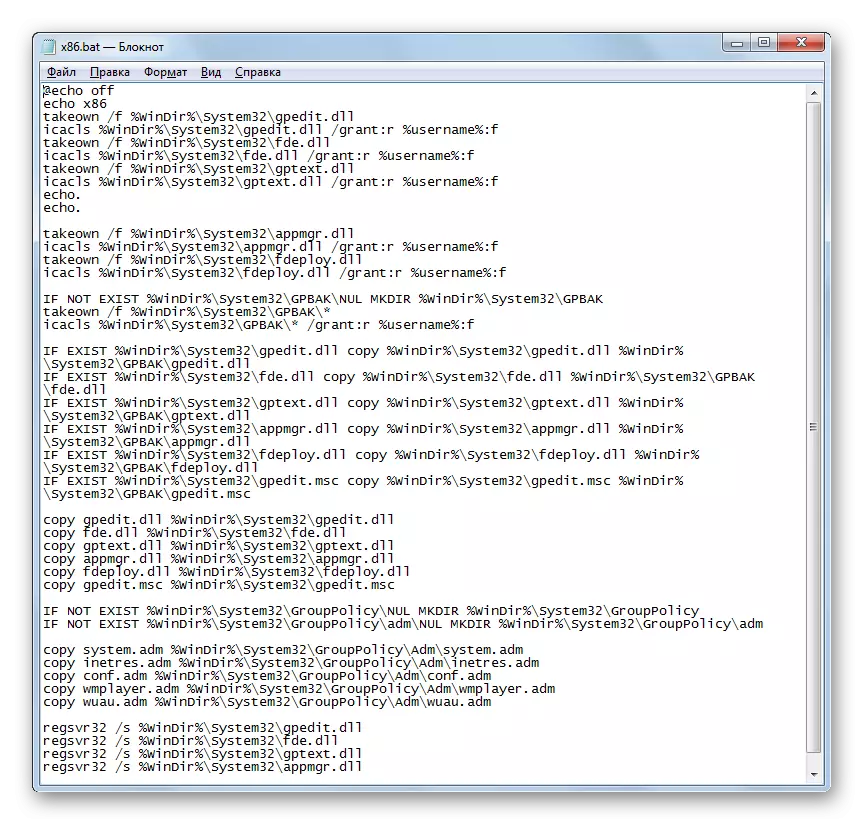
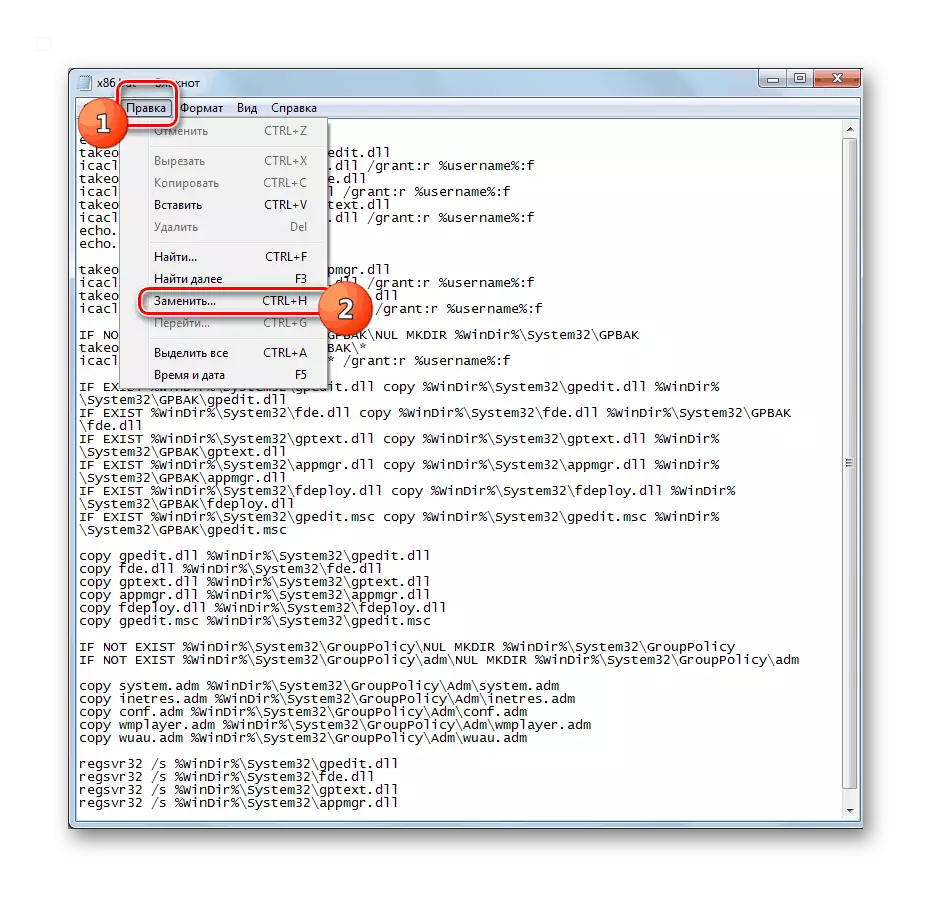
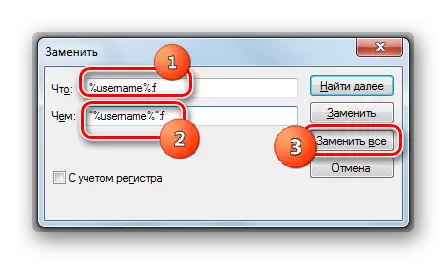
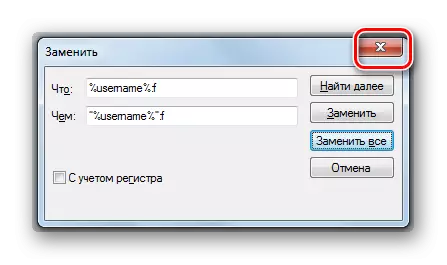
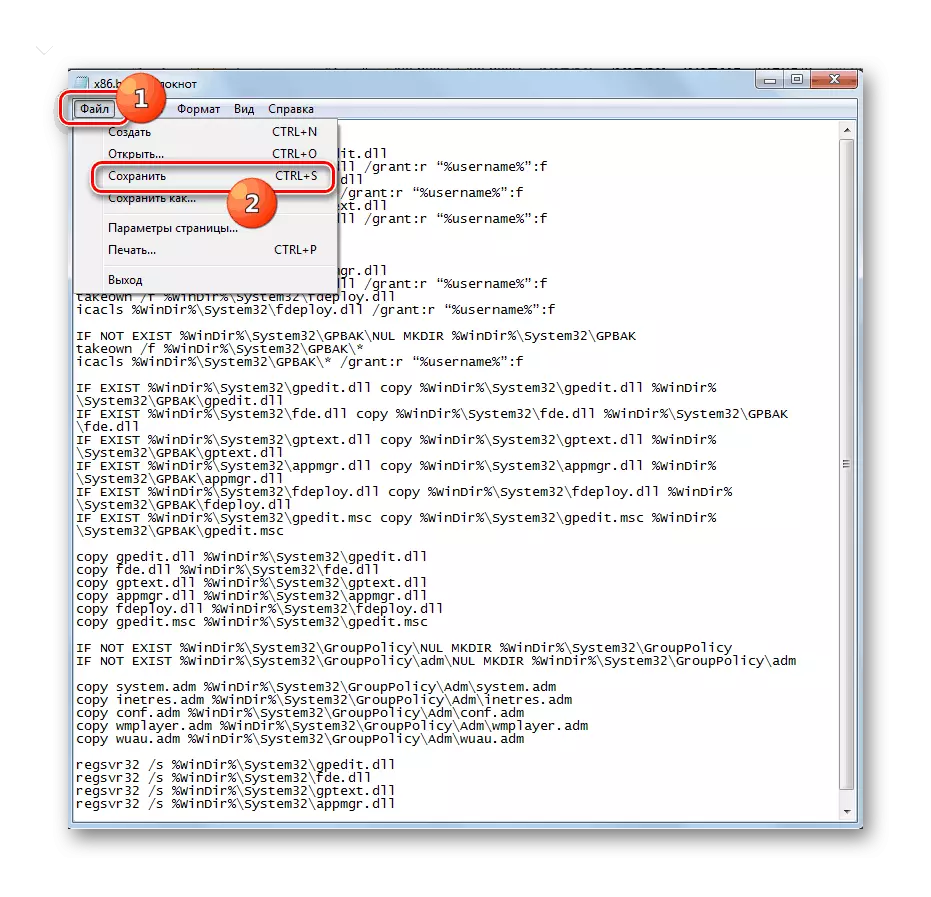
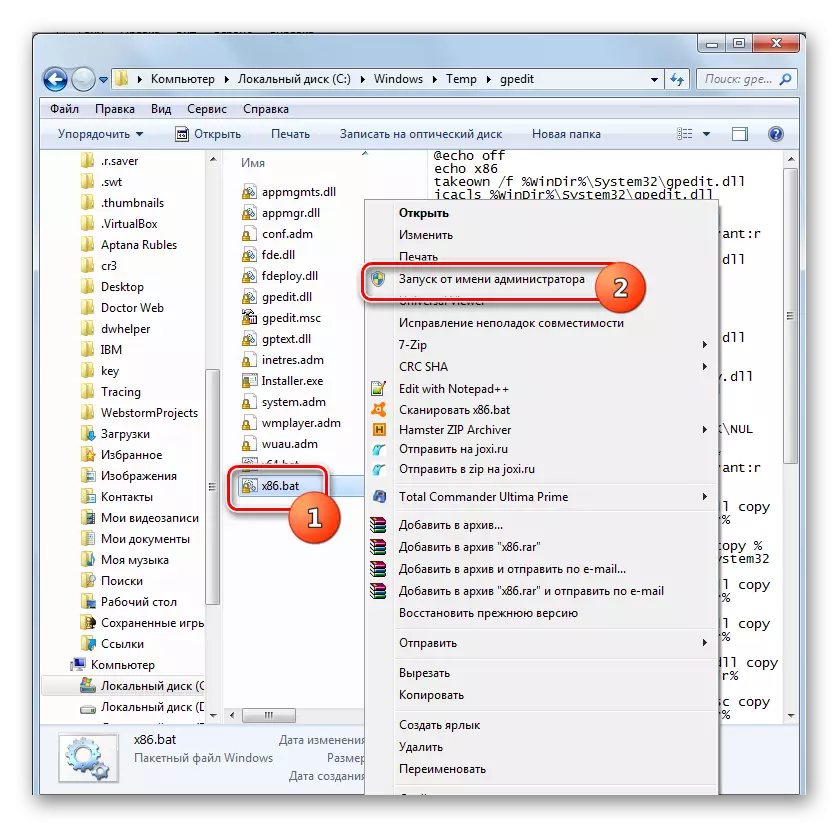
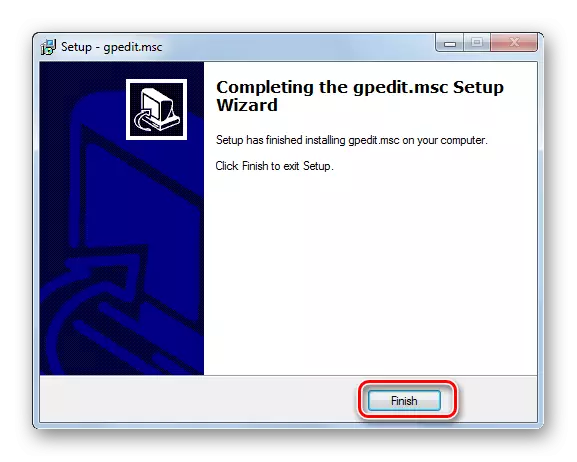
Method 2: Copying files from the GPBak catalog
The following method of restoring the operation of a remote or damaged object GPedit.msc, as well as related elements, is suitable exclusively for Windows 7 Professional, Enterprise and Ultimate. For these editions, this option is even more preferable than error correction using the first method, as it is associated with less risks, but the positive result is still not guaranteed. This recovery method is carried out by copying the contents of the GPBak directory, where there are backup original "Editor" objects in the System32 directory.
- Open the "Explorer". If you have a 32-bit OS, drive the following expression in the address bar:
% Windir% \ System32 \ Gpbak
If you use a 64-bit version, then enter such a code:
% Windir% \ syswow64 \ gpbak
Click the arrow to the right of the field.
- Highlight all the contents of the directory in which you hit. Click on the release of PCM. Choose "Copy".
- Then click in the address bar on the "Windows" inscription.
- Next locate the "System32" folder and go to it.
- In the opened directory, click PKM on any empty place. Select "Insert" in the menu.
- If necessary, confirm the insert with the replacement of all files.
- In the other type dialog box, press "continue."
- Then restart the PC and try to start the desired tool.
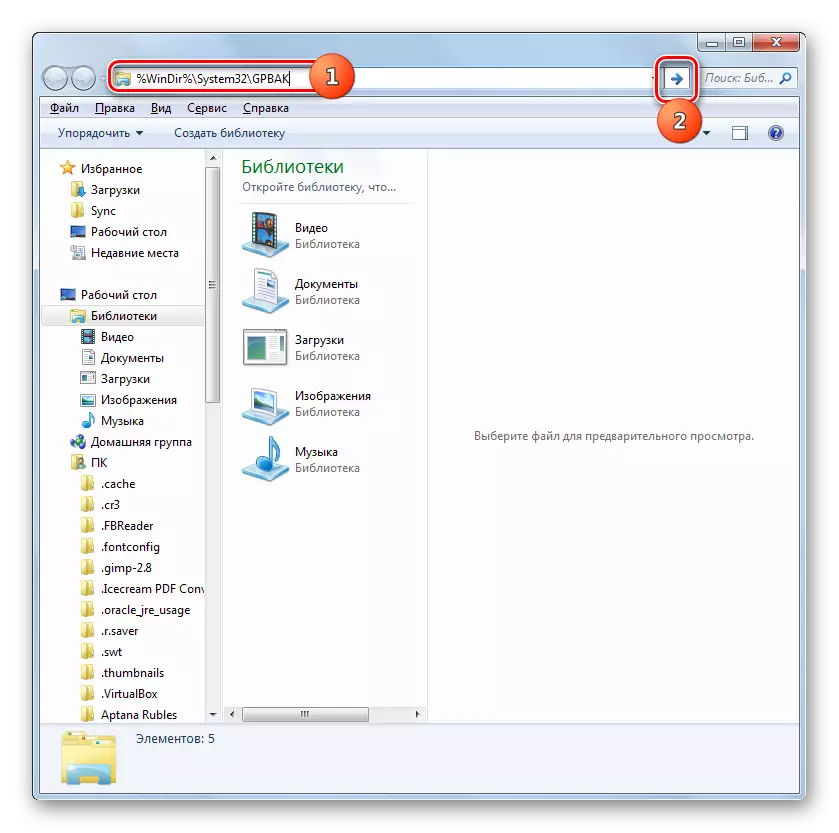
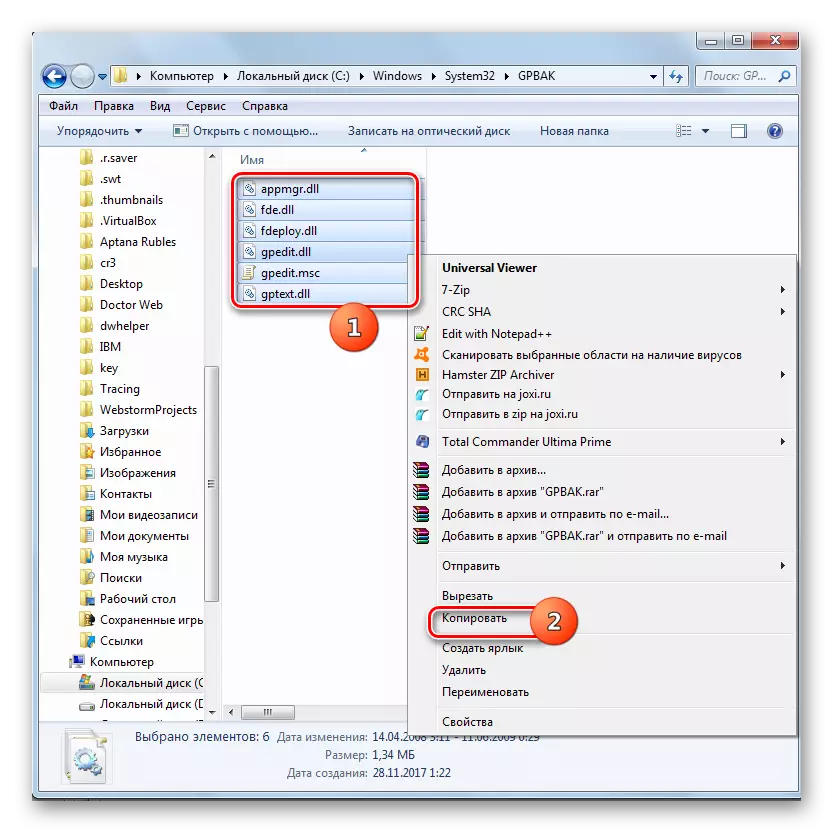
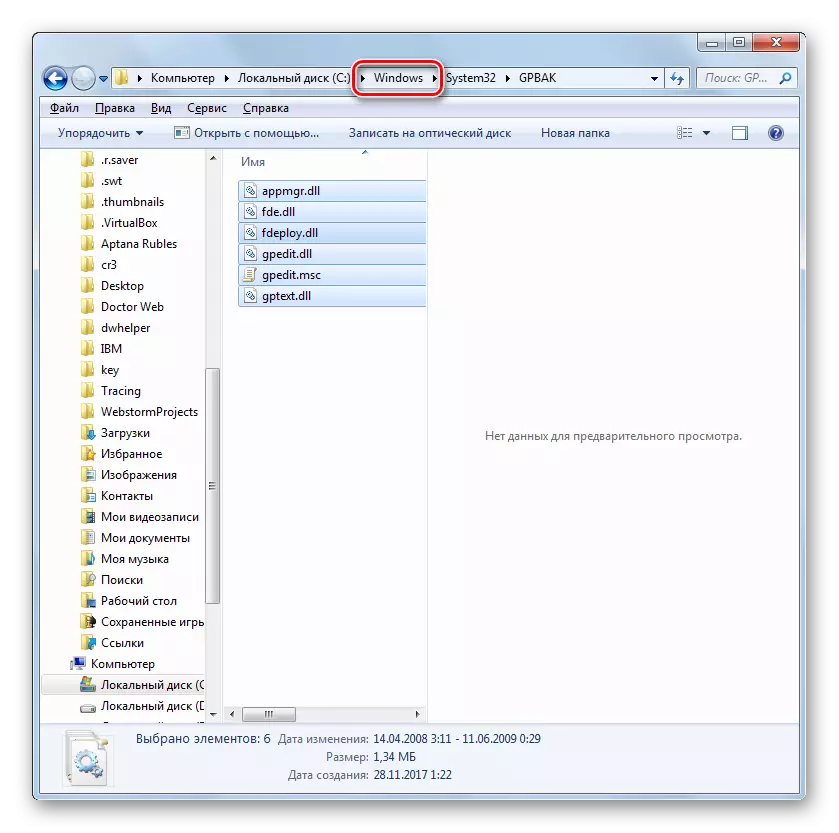
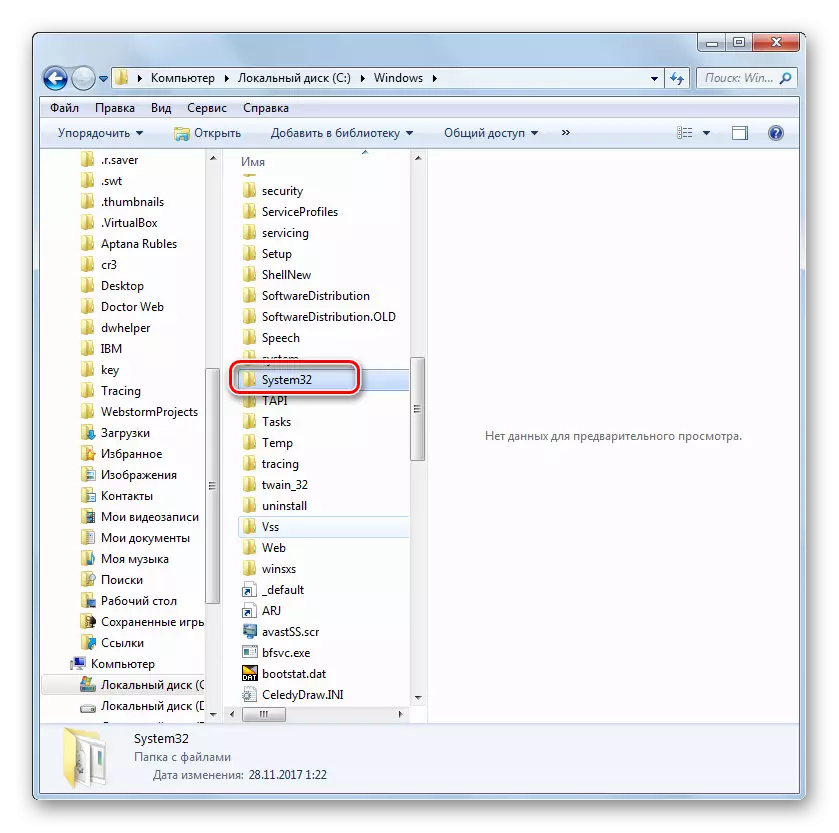
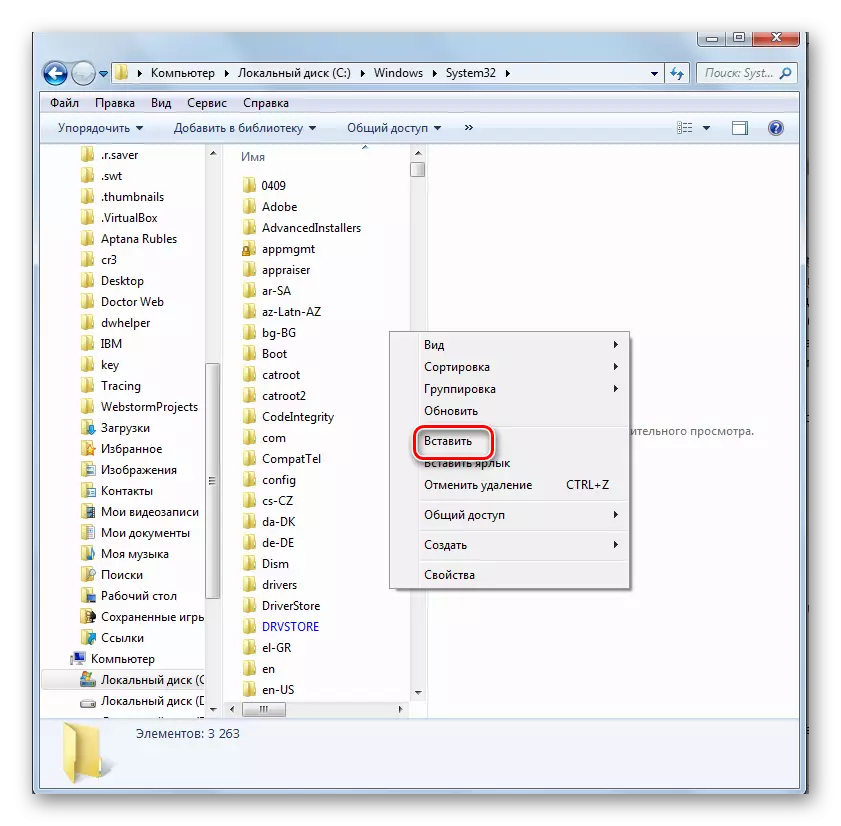
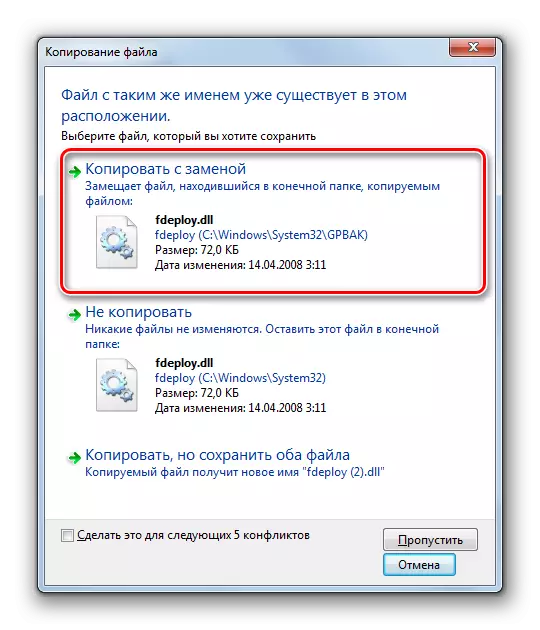
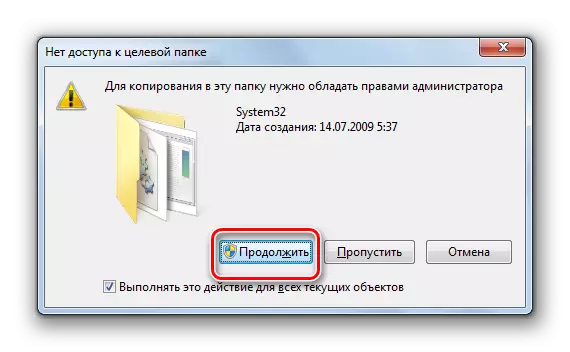
Method 3: Checking the integrity of the OS files
Considering that gpedit.msc and all related objects relate to system components, it is possible to restore the performance of the Group Policy Editor "by running the" SFC "utility designed to verify the integrity of the OS files and their recovery. But this option, as well as the previous one, works only in Professional, Enterprise and Ultimate editions.
- Click "Start". Come in all programs.
- Go to "Standard".
- In the list, find the "Command Line" object and click on it PCM. Choose "Run on the administrator".
- The "Command Line" will start with the authority of the administrator. Put in it:
SFC / SCANNOW.
Press ENTER.
- The procedure for checking the OS files, including the gpedit.msc, the "SFC" utility is launched. The dynamics of its execution is displayed as a percentage in the same window.
- After the scan is complete, the message should be displayed in the window, which states that damaged files were found and restored. But it may also be recorded an entry that the utility has found corrupted files, but is not able to fix some of them.
- In the latter case, you must scan the "SFC" utility through the "Command Line" on the computer running in "Safe Mode". Also, perhaps, copies of the necessary files are not stored on the hard drive. Then before scanning, you must insert the WINDOVS 7 installation disc to the drive, from which the OS was installed.
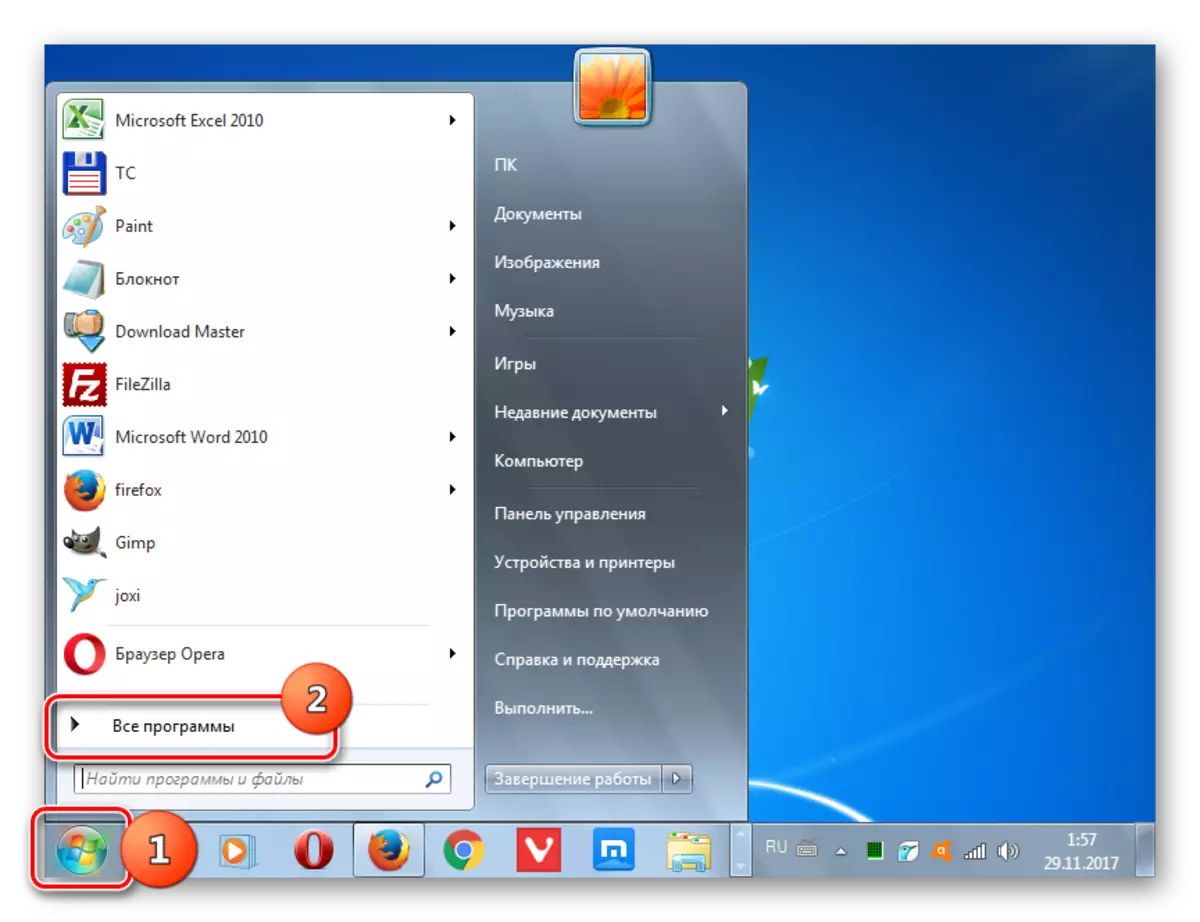
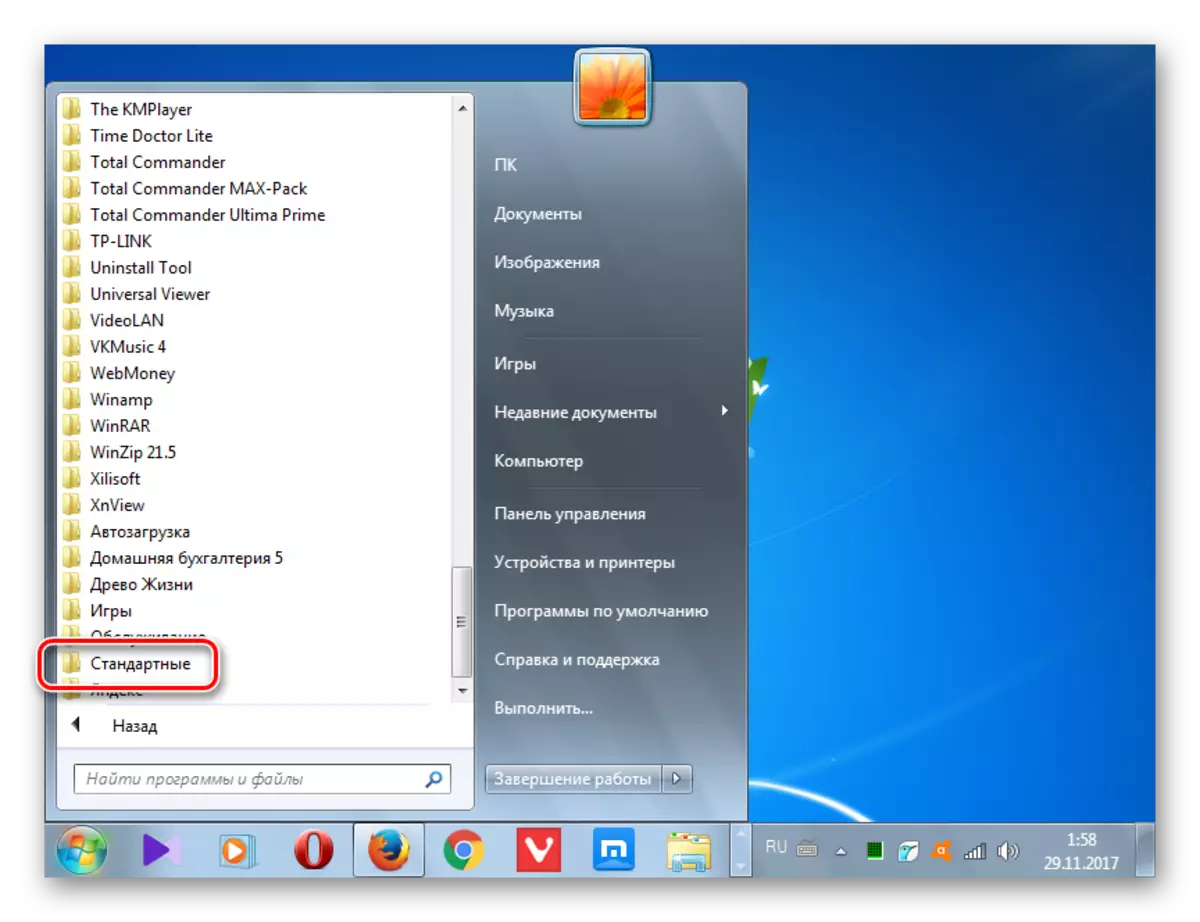
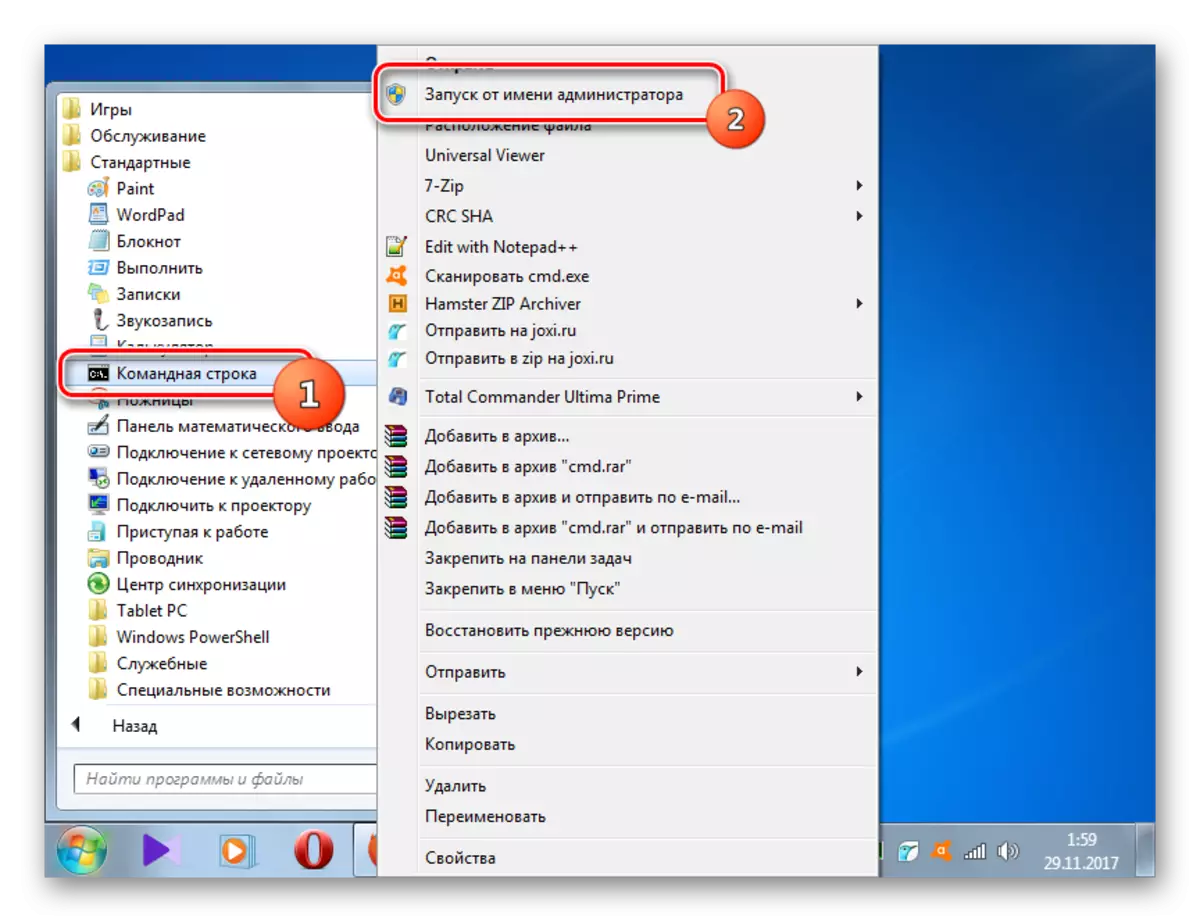
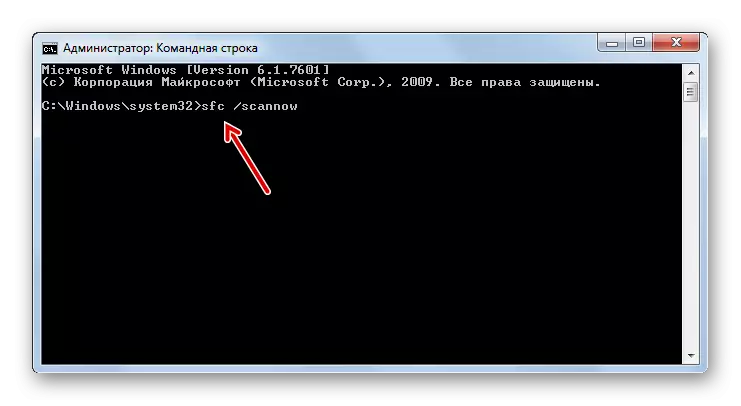
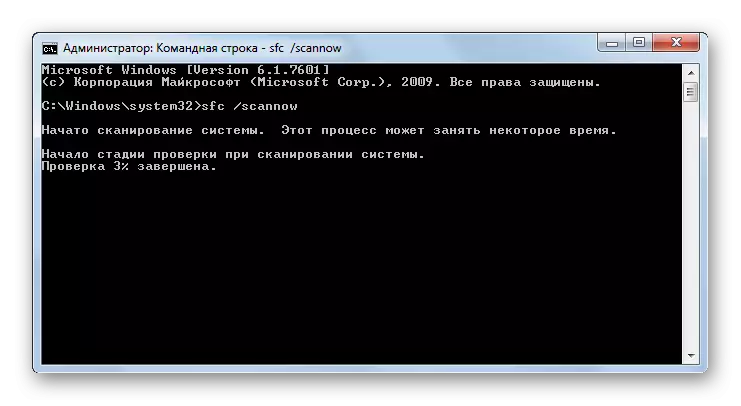
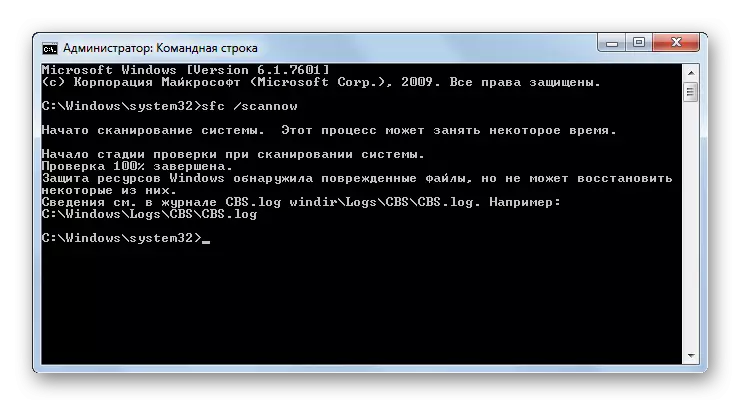
Read more:
Scanning the integrity of OS files in Windows 7
Challenge "Command Line" in Windows 7
Method 4: System Restore
If you are using the Professional, Enterprise and Ultimate editions and you have an OS recovery point on your computer, created before it became an error, that is, it makes sense to restore the full operability of the OS.
- Go through the "Start" folder "Standard". How to fulfill this, explained when considering the previous method. Then log in to the "Service" catalog.
- Click "Restore System".
- The system of system recovery utility will be launched. Click "Next".
- The window opens with a list of recovery points. There may be several of them. To more complete search, check the box near the "show other recovery points" parameter. Choose the option that was formed before the error began to appear. Highlight it and press "Next".
- In the next window to start the system recovery procedure, press "ready."
- The computer will be rebooted. After a complete recovery of the system, the problem with the error we studied should be abyss.
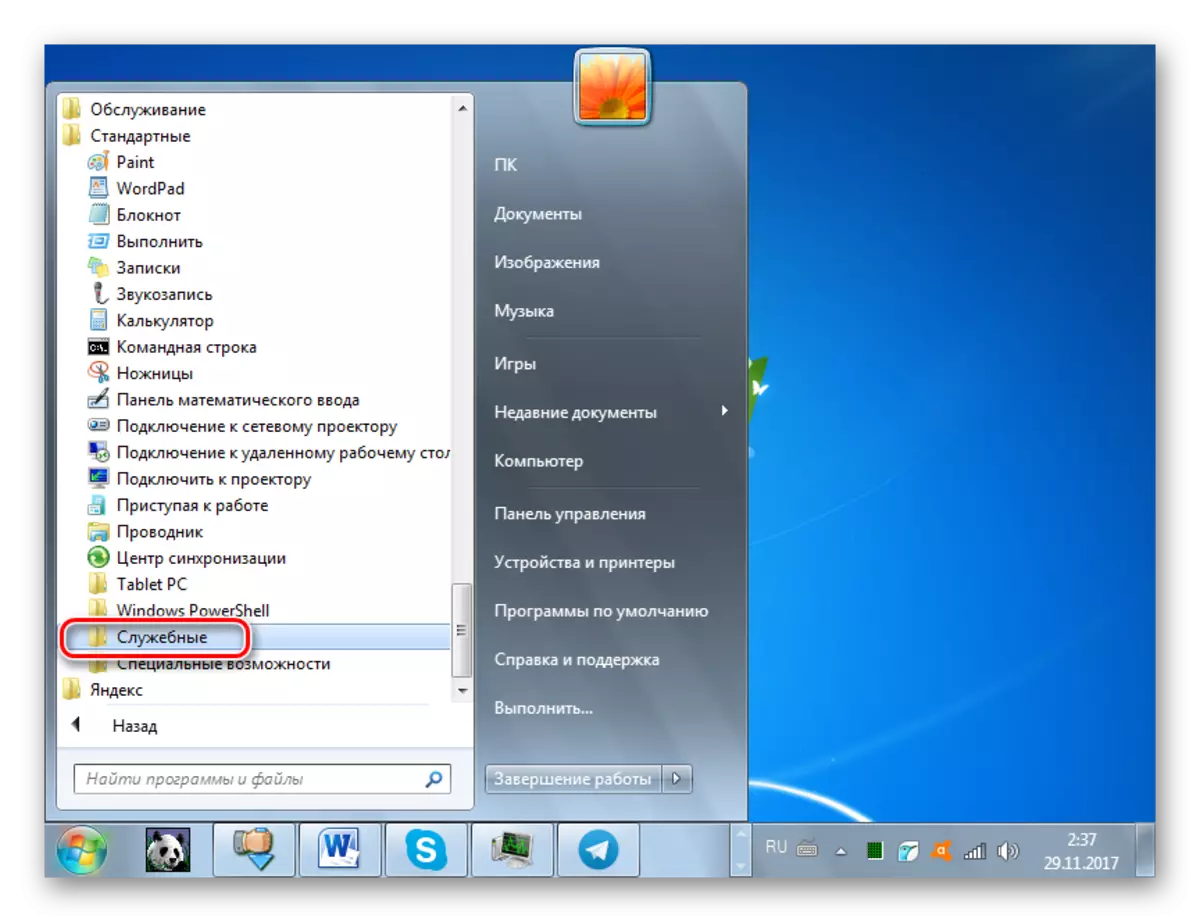
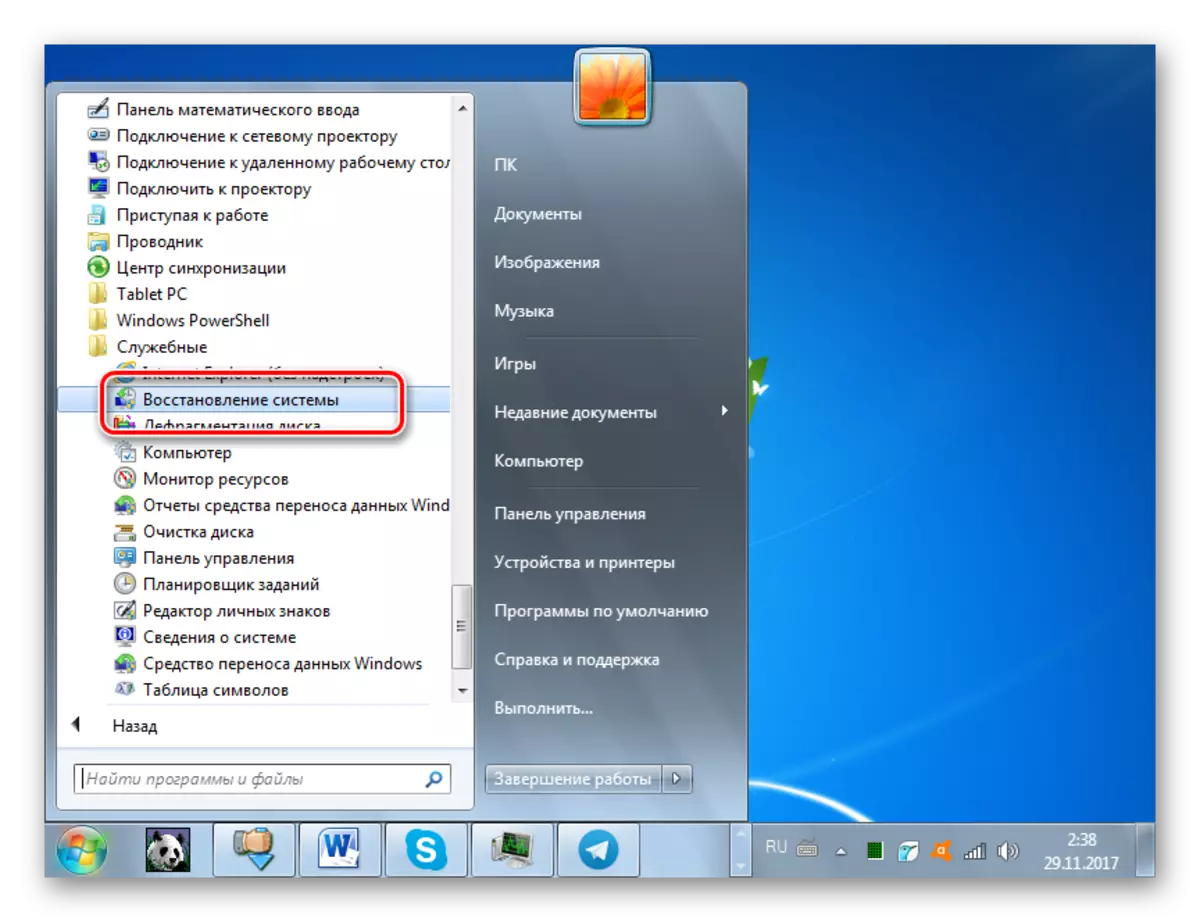
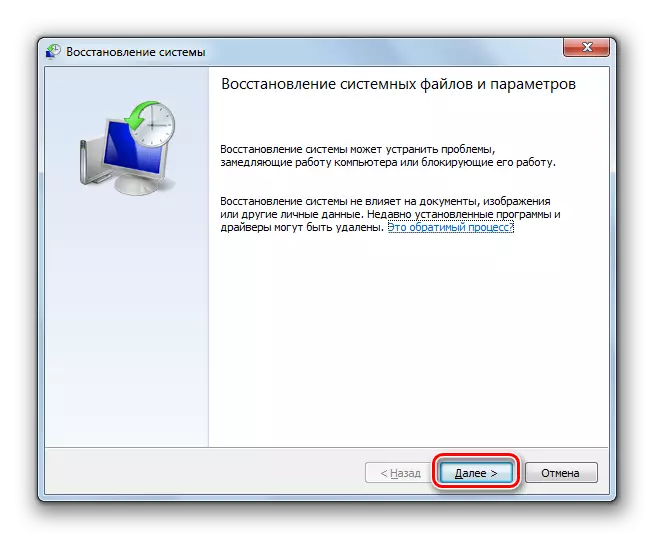
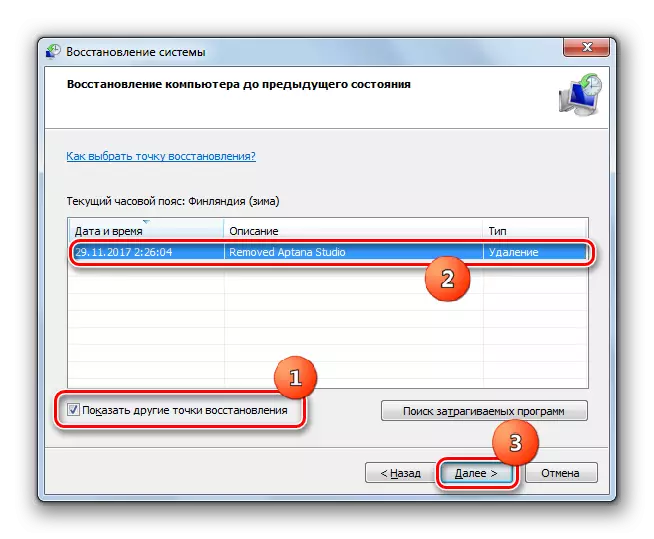
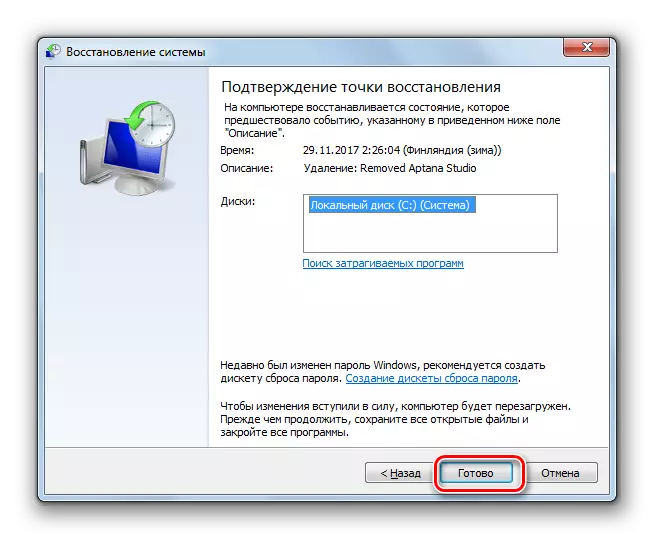
Method 5: Elimination of viruses
One of the reasons for the appearance of the error "gpedit.msc is not found" can be viral activity. If you proceed from the fact that malicious code has already been missed into the system, it is not possible to scan it with a full-time anti-virus. For this procedure, you need to use special utilities, such as Dr.Web Cureit. But even using third-party programs that do not provide them with installations, check for viruses is best done from another computer or booting with LiveCD or LiveUSB. If the utility detects the virus, then it is necessary to follow its recommendations.
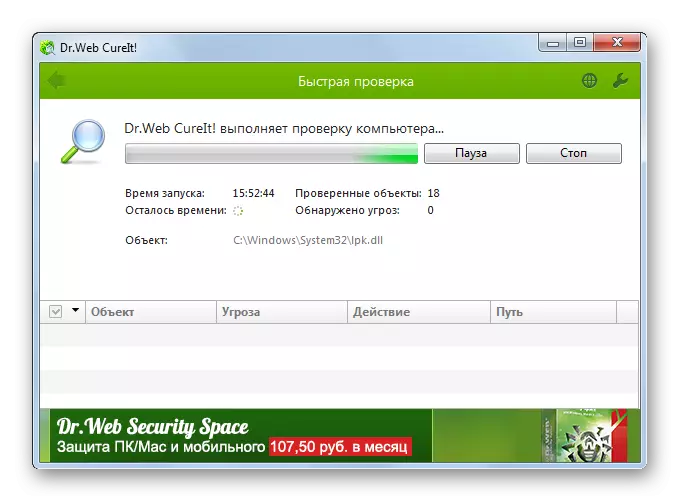
But even the detection and elimination of the virus, which led to the error we studied, does not guarantee the recovery of the "Group Policy Editor", since system files could be damaged. In this case, after neutralization, you will need to perform a recovery procedure according to one of the algorithms from those methods that are presented above.
Method 6: Reinstalling the operating system
If none of the specified methods helped you, then reinstalling the operating system remains the only option to correct the situation. This method is also suitable for users who do not want to mess with various settings and regenerating utilities, and prefer to solve a problem with one fell. Especially this method is relevant if the error "gpedit.msc is not found" is not the only problem on the computer.
In order to no longer face the problem described in this article, when installing, use a disk with Windows distribution 7 edition Professional, Enterprise or Ultimate, but not edition of Home Basic, Home Premium or Starter. Insert the media from the OS into the drive and restart the computer. Next, follow the recommendations that will be displayed on the monitor. After installing the necessary edition of the OS, the problem with the gpedit.msc should disappear.
As you can see, choosing a more convenient and actual way to solve the problem with the error "gpedit.msc is not found" on Windows 7 depends on many factors. These include the editorial office of the operating system and its discharge, as well as immediate causes that caused the problem. One of the options presented in this article can be used in almost all cases, while others apply exclusively for a specific set of conditions.
